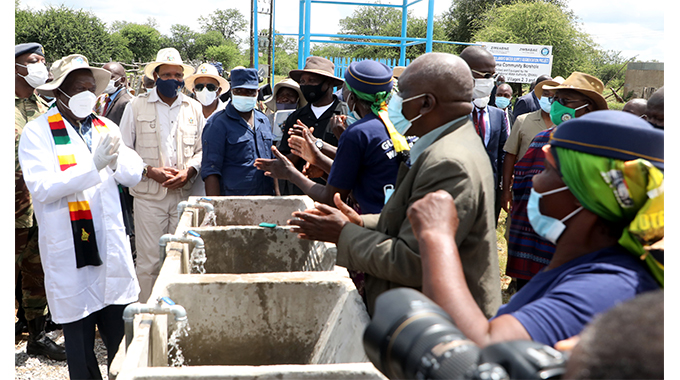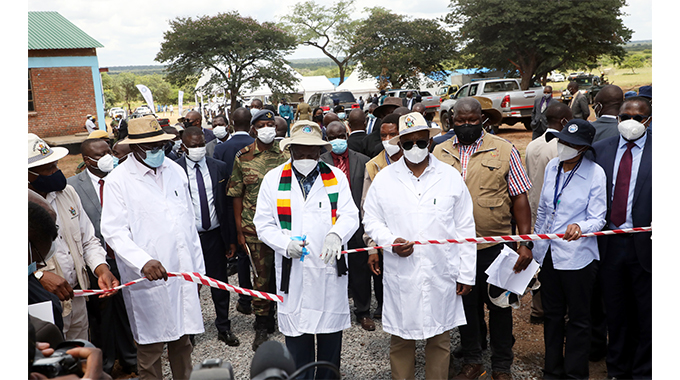
THE Gwayi-Shangani Dam project will be completed in December this year with the 245km pipeline that connects the dam to Bulawayo set to be completed in 2022, as President Mnangagwa’s Government pushes to fulfil the century-old dream to permanently solve Matabeleland region’s water problems through the National Matabeleland Zambezi Water Project (NMZWP).

The President tours the community borehole at Nyamandlovu. Accompanying him are the two Vice-Presidents Kembo Mohadi and Dr Constantino Chiwenga and senior Governments officials
The dam, with a holding capacity of 650 million cubic metres of water, and pipeline project are major components of the NMZWP, which was first mooted in 1912 but has failed to take off under previous successive administrations.
It is only after the coming in of the Second Republic led by President Mnangagwa that the project has received significant fiscal support and political will that has seen it taking off at an accelerated pace.

The project involves various phases which include the construction of the Gwayi-Shangani Dam, the construction of a pipeline from the dam to Bulawayo and another pipeline which will draw water from the Zambezi River.
The speedy implementation has been received with huge excitement in the southern region, on the background of perceived historical marginalisation and underdevelopment of the Matabeleland region, in particular.
President Mnangagwa yesterday said reliable water supplies and other enablers must position Bulawayo as an attractive investment destination and the country’s industrial hub.
The move by Government sets the pace for increased food production along the greenbelt, robust investment attraction and industrialisation of Matabeleland North, which will lead to creation of more job opportunities down the value chain.
The first phase of the project, the Gwayi-Shangani Dam is on course and 40 percent complete with $4,5 billion allocated for the project in the 2021 National Budget.
The Government also allocated $535 million towards the commencement of work on the 245km Gwayi-Shangani–Bulawayo pipeline whose completion is expected by December 2022.
President Mnangagwa said the project timelines are expected to coincide with the Gwayi-Shangani Dam receiving substantial water inflow for conveyance to Bulawayo.
On completion, President Mnangagwa said, the pipeline will convey 160 000 megalitres of water to Bulawayo daily, a development that will improve the water and sanitation requirements of the city.
The President yesterday presided over the groundbreaking ceremony for the Gwayi-Shangani-Bulawayo Pipeline Project in Nyamandlovu, Umguza District in Matabeleland North, marking the commencement of the NMZWP.
Moving away from the old tradition of using a shovel for groundbreaking, President Mnangagwa used an excavator to dig along the trench where the pipeline will go, symbolising full intent to fulfil his promise of achieving the 100-year-old dream.
“Let me assure you that this National Matabeleland Zambezi Water Project will become a reality during my administration,” declared President Mnangagwa.
He also commissioned the Epping Forest Water Supply Augmentation Project for the City of Bulawayo, describing the two occasions as a remarkable milestone in the Government’s quest to improve water security and supply to Bulawayo and surrounding areas.
Speaking after the groundbreaking ceremony, President Mnangagwa said the Government had made serious strides towards the implementation of the NMZWP.
“This pipeline, when it is completely constructed and laid out, will come from Zambezi to Bulawayo but this first phase will get water from Gwayi-Shangani Dam which is now 40 percent complete.
“We believe that in no time, once there is mitigation on the Covid-19 pandemic, the engineers from China will be back and continue the construction,” said President Mnangagwa.
“Meanwhile, on our side we are laying the pipeline from Gwayi down to Bulawayo so we will be able to supply Bulawayo with adequate water from Gwayi-Shangani.”
Later, when giving his keynote address for both events, President Mnangagwa said the pipeline project will be undertaken by various local contractors on different sections.
This, he said, will not only speed up completion of the civil works, but equally provide employment and empowerment for contractors and communities along the construction route.
President Mnangagwa said plans for an irrigation scheme covering 10 hectares in the vicinity of the dam are now in place.
“In addition, the large volume of water from the project will propel irrigation activities along the pipeline route in parts of Lupane, Tsholotsho and Umguza districts. Matabeleland North will therefore become food secure and an exporter of surplus agricultural produce as well as play host to viable rural industry systems,” said President Mnangagwa.
“The idea of turning this region into a greenbelt is not only logical but compelling and realistic. This strategic project will thus have a far-reaching impact towards accelerating agriculture, production, productivity and growth in this part of the country.”
President Mnangagwa said the project will change the livelihoods of the people of Matabeleland region and beyond and broaden their economic empowerment activities.
“This resonates with my administration’s commitment to equalisation principles under the devolution and decentralisation agenda. I, therefore, challenge communities to maintain the momentum and unity of purpose which has resulted in the development milestones we are recording across the country,” he said.
“No one and no place in our country should be left behind. There are no spectators in the projects which my Government continues to roll out, our people must be organised as both participants and beneficiaries.”
President Mnangagwa urged communities to guard against vandalism of infrastructure to ensure sustainability of the projects.
“Over the years, the region has repeatedly called for the Zambezi Water Project, the Second Republic has heard you and is delivering. This culture of unity, dialogue and collaboration is encouraged going forward. First and foremost, we are all Zimbabweans, together we are achieving the good of our people and our beloved country,” said the President.
Turning to the Epping Forest Project, President Mnangagwa said it followed the completion of a similar one carried by Government at Rochester in May 2020 which resulted in the delivery of 10 mega litres of water to Bulawayo.

President commission Epping Forest project
With the addition of the Epping Forest Project, Bulawayo will receive 20 megalitres of water from the underground water resources.
Both projects are short term interventions by Government to ensure the provision of clean and affordable portable water in Bulawayo.
Additionally, President Mnangagwa said a community borehole, that he also commissioned, is for families in the area with a capacity to irrigate 10 hectares of horticultural produce and also provide water for livestock.
